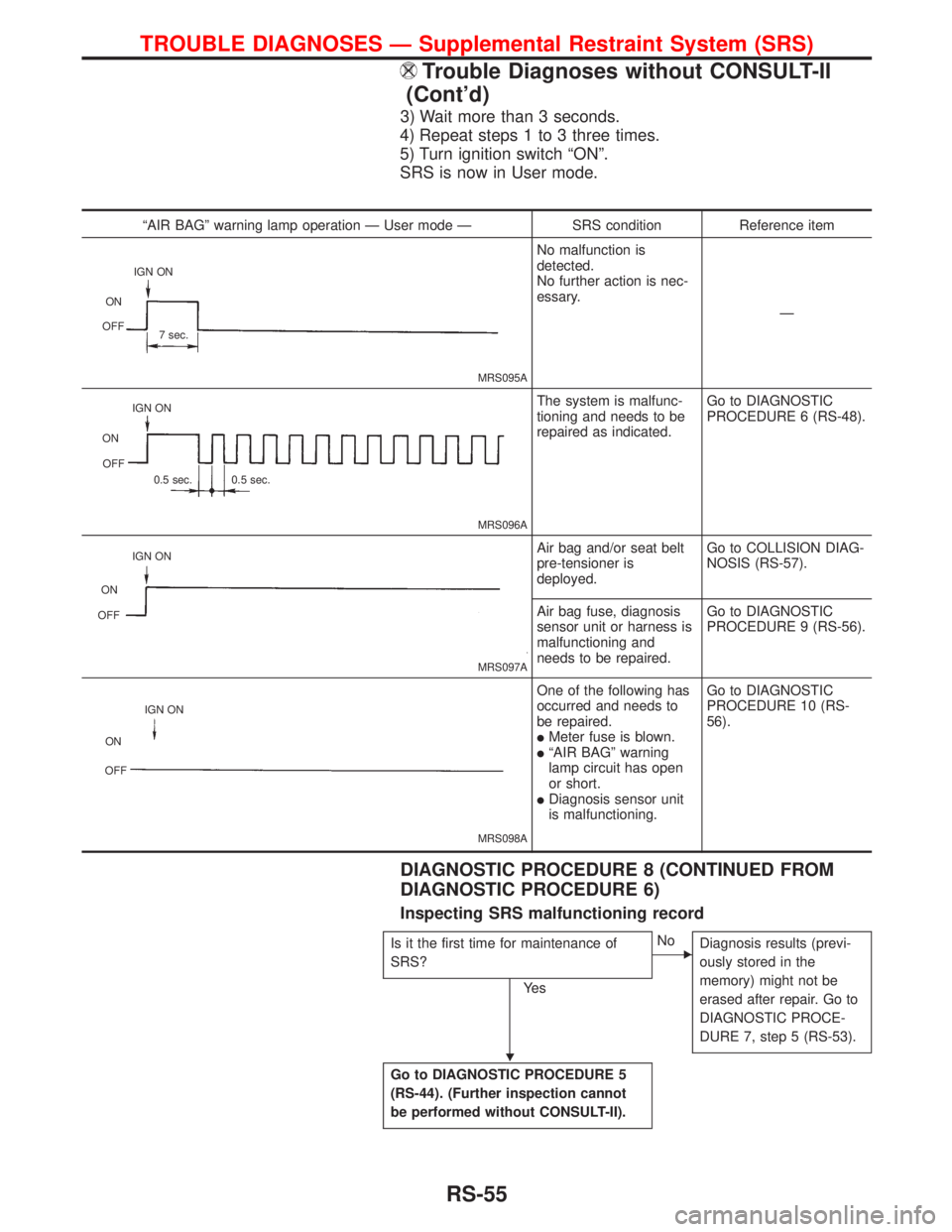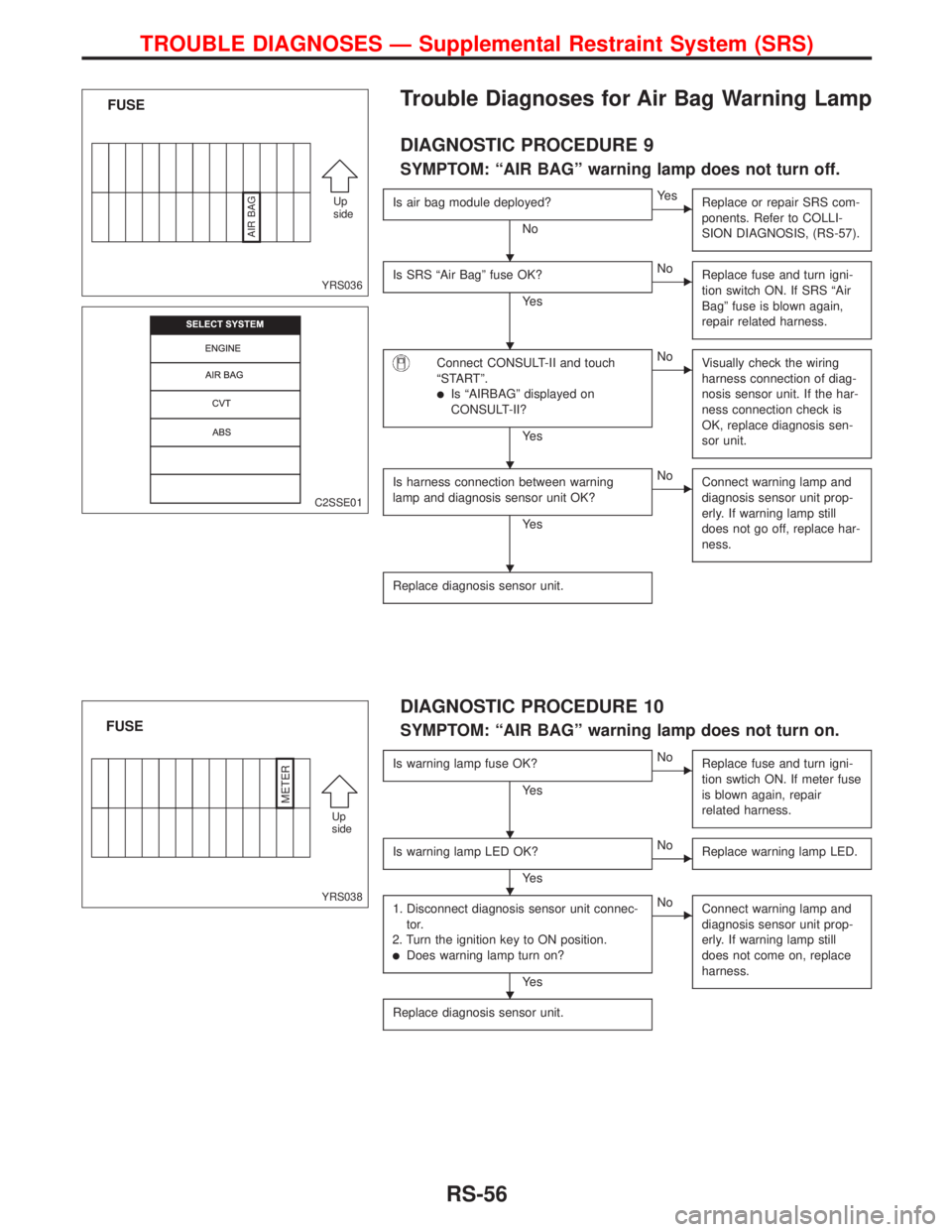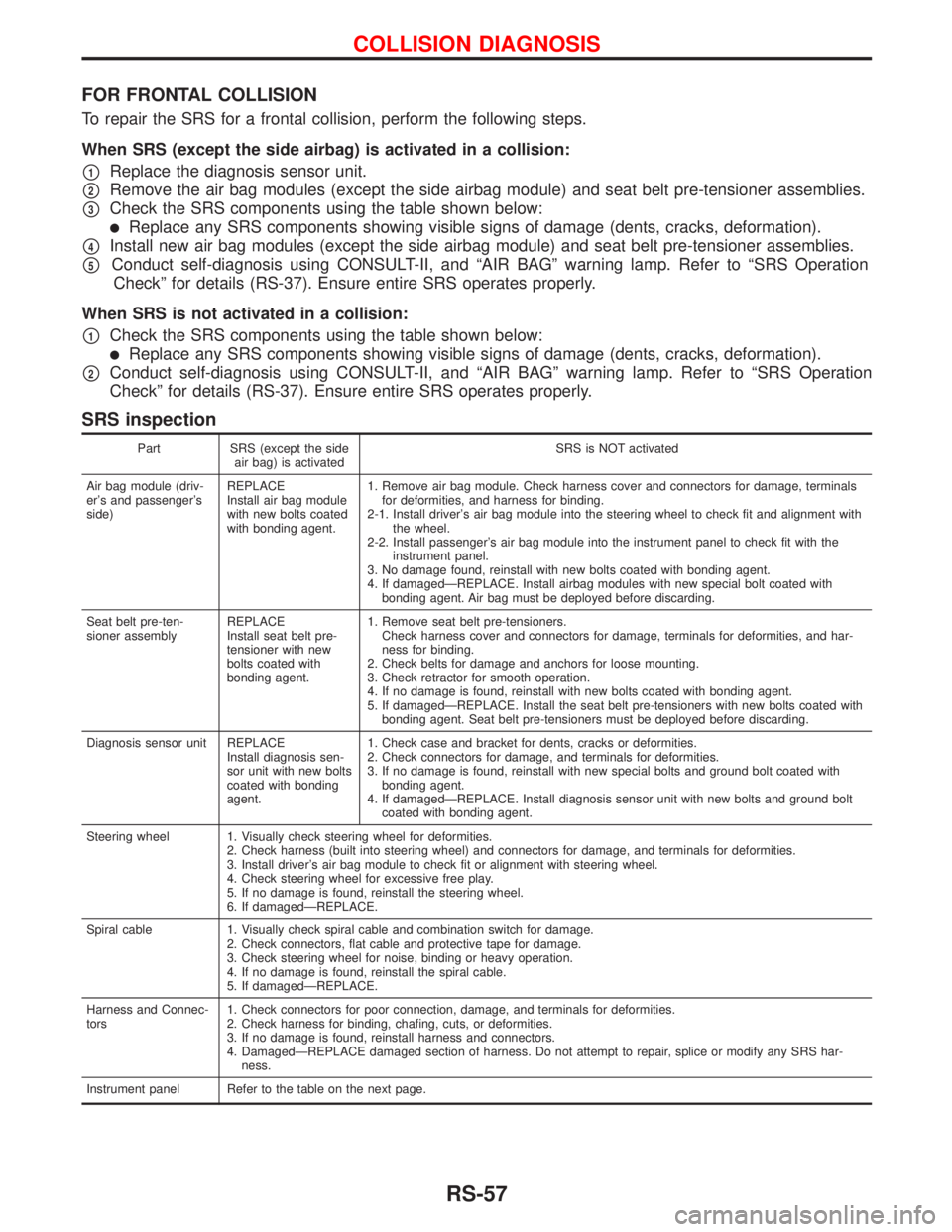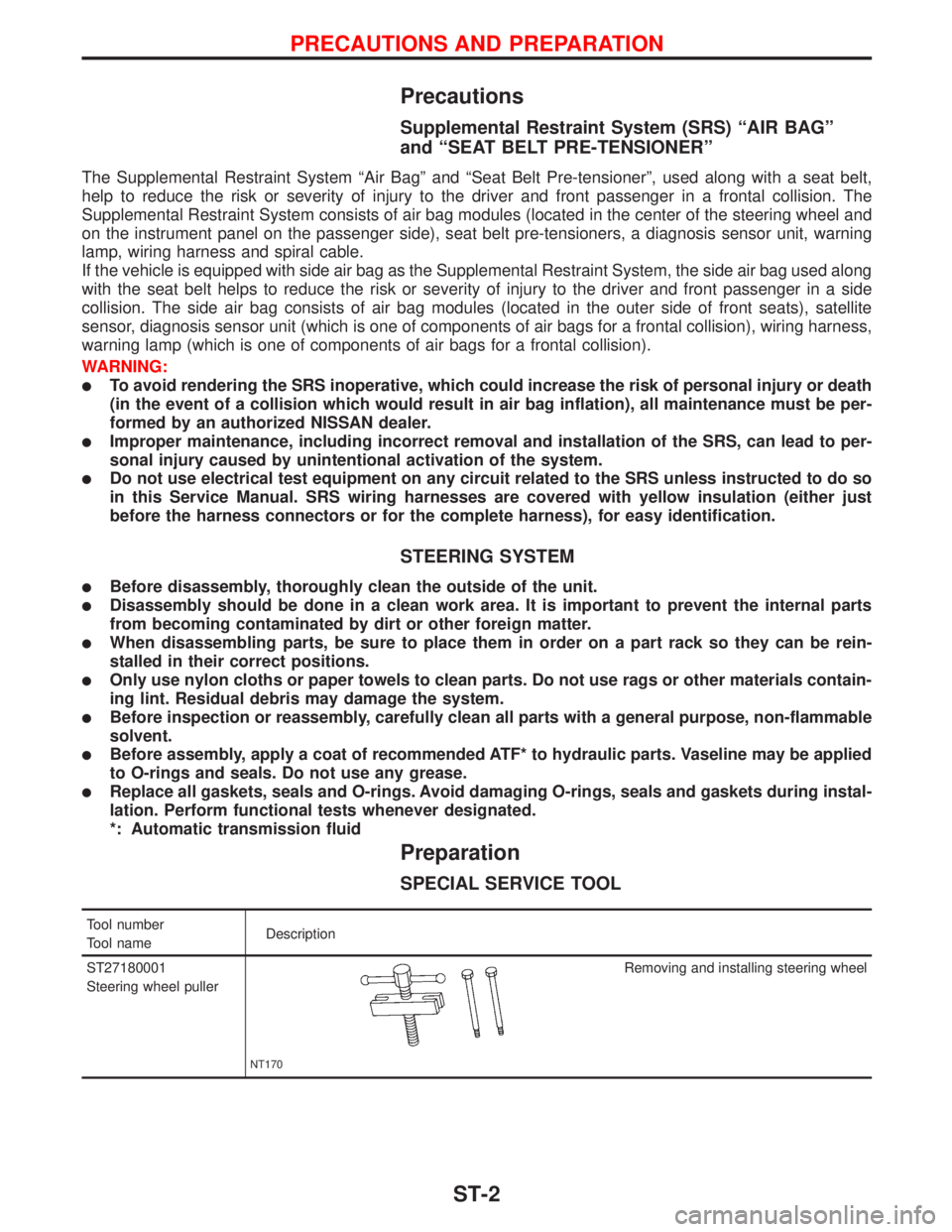1999 NISSAN PRIMERA sensor
[x] Cancel search: sensorPage 2238 of 2267

3) Wait more than 3 seconds.
4) Repeat steps 1 to 3 three times.
5) Turn ignition switch ªONº.
SRS is now in User mode.
DIAGNOSTIC PROCEDURE 8 (CONTINUED FROM
DIAGNOSTIC PROCEDURE 6)
Inspecting SRS malfunctioning record
Is it the first time for maintenance of
SRS?
Ye s
ENo
Diagnosis results (previ-
ously stored in the
memory) might not be
erased after repair. Go to
DIAGNOSTIC PROCE-
DURE 7, step 5 (RS-53).
Go to DIAGNOSTIC PROCEDURE 5
(RS-44). (Further inspection cannot
be performed without CONSULT-II).
ªAIR BAGº warning lamp operation Ð User mode Ð SRS condition Reference item
MRS095A
No malfunction is
detected.
No further action is nec-
essary.
Ð
MRS096A
The system is malfunc-
tioning and needs to be
repaired as indicated.Go to DIAGNOSTIC
PROCEDURE 6 (RS-48).
MRS097A
Air bag and/or seat belt
pre-tensioner is
deployed.Go to COLLISION DIAG-
NOSIS (RS-57).
Air bag fuse, diagnosis
sensor unit or harness is
malfunctioning and
needs to be repaired.Go to DIAGNOSTIC
PROCEDURE 9 (RS-56).
MRS098A
One of the following has
occurred and needs to
be repaired.
lMeter fuse is blown.lªAIR BAGº warning
lamp circuit has open
or short.
lDiagnosis sensor unit
is malfunctioning.Go to DIAGNOSTIC
PROCEDURE 10 (RS-
56).
IGN ON
ON
OFF
7 sec.
IGN ON
ON
OFF
0.5 sec. 0.5 sec.
IGN ON
ON
OFF
IGN ON
ON
OFF
H
TROUBLE DIAGNOSES Ð Supplemental Restraint System (SRS)
Trouble Diagnoses without CONSULT-II
(Cont'd)
RS-55
Page 2239 of 2267

Trouble Diagnoses for Air Bag Warning Lamp
DIAGNOSTIC PROCEDURE 9
SYMPTOM: ªAIR BAGº warning lamp does not turn off.
Is air bag module deployed?
No
EYe s
Replace or repair SRS com-
ponents. Refer to COLLI-
SION DIAGNOSIS, (RS-57).
Is SRS ªAir Bagº fuse OK?
Ye s
ENo
Replace fuse and turn igni-
tion switch ON. If SRS ªAir
Bagº fuse is blown again,
repair related harness.
Connect CONSULT-II and touch
ªSTARTº.
lIs ªAIRBAGº displayed on
CONSULT-II?
Ye s
ENo
Visually check the wiring
harness connection of diag-
nosis sensor unit. If the har-
ness connection check is
OK, replace diagnosis sen-
sor unit.
Is harness connection between warning
lamp and diagnosis sensor unit OK?
Ye s
ENo
Connect warning lamp and
diagnosis sensor unit prop-
erly. If warning lamp still
does not go off, replace har-
ness.
Replace diagnosis sensor unit.
DIAGNOSTIC PROCEDURE 10
SYMPTOM: ªAIR BAGº warning lamp does not turn on.
Is warning lamp fuse OK?
Ye s
ENo
Replace fuse and turn igni-
tion swtich ON. If meter fuse
is blown again, repair
related harness.
Is warning lamp LED OK?
Ye s
ENo
Replace warning lamp LED.
1. Disconnect diagnosis sensor unit connec-
tor.
2. Turn the ignition key to ON position.
lDoes warning lamp turn on?
Ye s
ENo
Connect warning lamp and
diagnosis sensor unit prop-
erly. If warning lamp still
does not come on, replace
harness.
Replace diagnosis sensor unit.
YRS036
FUSE
Up
side
AIR BAG
C2SSE01
YRS038
FUSE
Up
side
METER
H
H
H
H
H
H
H
TROUBLE DIAGNOSES Ð Supplemental Restraint System (SRS)
RS-56
Page 2240 of 2267

FOR FRONTAL COLLISION
To repair the SRS for a frontal collision, perform the following steps.
When SRS (except the side airbag) is activated in a collision:
p1Replace the diagnosis sensor unit.
p2Remove the air bag modules (except the side airbag module) and seat belt pre-tensioner assemblies.
p3Check the SRS components using the table shown below:
lReplace any SRS components showing visible signs of damage (dents, cracks, deformation).
p4Install new air bag modules (except the side airbag module) and seat belt pre-tensioner assemblies.
p5Conduct self-diagnosis using CONSULT-II, and ªAIR BAGº warning lamp. Refer to ªSRS Operation
Checkº for details (RS-37). Ensure entire SRS operates properly.
When SRS is not activated in a collision:
p1Check the SRS components using the table shown below:
lReplace any SRS components showing visible signs of damage (dents, cracks, deformation).
p2Conduct self-diagnosis using CONSULT-II, and ªAIR BAGº warning lamp. Refer to ªSRS Operation
Checkº for details (RS-37). Ensure entire SRS operates properly.
SRS inspection
Part SRS (except the side
air bag) is activatedSRS is NOT activated
Air bag module (driv-
er's and passenger's
side)REPLACE
Install air bag module
with new bolts coated
with bonding agent.1. Remove air bag module. Check harness cover and connectors for damage, terminals
for deformities, and harness for binding.
2-1. Install driver's air bag module into the steering wheel to check fit and alignment with
the wheel.
2-2. Install passenger's air bag module into the instrument panel to check fit with the
instrument panel.
3. No damage found, reinstall with new bolts coated with bonding agent.
4. If damagedÐREPLACE. Install airbag modules with new special bolt coated with
bonding agent. Air bag must be deployed before discarding.
Seat belt pre-ten-
sioner assemblyREPLACE
Install seat belt pre-
tensioner with new
bolts coated with
bonding agent.1. Remove seat belt pre-tensioners.
Check harness cover and connectors for damage, terminals for deformities, and har-
ness for binding.
2. Check belts for damage and anchors for loose mounting.
3. Check retractor for smooth operation.
4. If no damage is found, reinstall with new bolts coated with bonding agent.
5. If damagedÐREPLACE. Install the seat belt pre-tensioners with new bolts coated with
bonding agent. Seat belt pre-tensioners must be deployed before discarding.
Diagnosis sensor unit REPLACE
Install diagnosis sen-
sor unit with new bolts
coated with bonding
agent.1. Check case and bracket for dents, cracks or deformities.
2. Check connectors for damage, and terminals for deformities.
3. If no damage is found, reinstall with new special bolts and ground bolt coated with
bonding agent.
4. If damagedÐREPLACE. Install diagnosis sensor unit with new bolts and ground bolt
coated with bonding agent.
Steering wheel 1. Visually check steering wheel for deformities.
2. Check harness (built into steering wheel) and connectors for damage, and terminals for deformities.
3. Install driver's air bag module to check fit or alignment with steering wheel.
4. Check steering wheel for excessive free play.
5. If no damage is found, reinstall the steering wheel.
6. If damagedÐREPLACE.
Spiral cable 1. Visually check spiral cable and combination switch for damage.
2. Check connectors, flat cable and protective tape for damage.
3. Check steering wheel for noise, binding or heavy operation.
4. If no damage is found, reinstall the spiral cable.
5. If damagedÐREPLACE.
Harness and Connec-
tors1. Check connectors for poor connection, damage, and terminals for deformities.
2. Check harness for binding, chafing, cuts, or deformities.
3. If no damage is found, reinstall harness and connectors.
4. DamagedÐREPLACE damaged section of harness. Do not attempt to repair, splice or modify any SRS har-
ness.
Instrument panel Refer to the table on the next page.
COLLISION DIAGNOSIS
RS-57
Page 2242 of 2267

FOR SIDE COLLISION
To repair the SRS for a side collision, perform the following steps.
When the built-in type front side air bag is activated in the side collision:
p1Replace the following components:
þ All parts of front seat back (including front seat back frame) with side air bag modules (on the side on
which side air bag is activated)
þ Diagnosis sensor unit
þ Satellite sensor (on the side on which side air bag is activated)
p2Check the SRS components and the related parts using the table shown below.
lReplace the SRS components and the related parts showing visible signs of damage (dents, cracks,
deformation).
p3Conduct self-diagnosis using CONSULT-II, or ªAIR BAGº warning lamp. Refer to ªSRS Operation Checkº
for details (RS-37). Ensure entire SRS operates properly.
When SRS is not activated in the side collision:
p1Check the SRS components and the related parts using the table shown below.
lReplace any SRS components and the related parts showing visible signs of damage (dents, cracks,
deformation).
p2Conduct self-diagnosis using CONSULT-II, or ªAIR BAGº warning lamp. Refer to ªSRS Operation Checkº
for details (RS-37). Ensure entire SRS operates properly.
In the case of the side collision
Part Side air bag is
activatedSRS is NOT activated
Built-in type front
side air bags mod-
ule (LH or RH)REPLACE all parts
of seat back with
deployed side air
bag module.1. Check for visible sign of damage (dents, tears, deformation) of the seat back
on the collision side.
2. If damagedÐREPLACE the damaged seat parts with new bolts and remove
the side air bag module.
3. Check for visible signs of damage (tears etc.) of the side air bag module.
4. Check harness and connectors for damage, and terminals for deformities.
5. If no damage is found, reinstall the side air bag module with new torx nuts
coated with bonding agent.
6. If damagedÐREPLACE the side air bag module with new torx nuts coated
with bonding agent. Air bag must be deployed before disposing of it.
Satellite sensor (LH
or RH)REPLACE the sat-
ellite sensor on the
collision side with
new nuts.
(Repair the center
pillar inner, etc.
before installing
new one if dam-
aged.)1. Remove the satellite sensor on the collision side. Check harness connectors
for damage, terminals for deformities, and harness for binding.
2. Check for visible signs of damage (dents, cracks, deformation) of the satel-
lite sensor.
3. Install the satellite sensor to check fit.
4. If no damage is found, reinstall the satellite sensor with new nuts coated with
bonding agent.
5. If damagedÐREPLACE the satellite sensor with new nuts coated with bond-
ing agent.
Diagnosis sensor REPLACE the
diagnosis sensor
unit with the new
bolts.1. Check case and bracket for dents, cracks or deformities.
2. Check connectors for damage, and terminals for deformities.
3. If no damage is found, reinstall the diagnosis sensor unit with new special
bolts and ground bolt coated with bonding agent.
4. If damagedÐREPLACE the diagnosis sensor unit with new special bolts and
ground bolt coated with bonding agent.
Seat belt pre-ten-
sioner assembly1. Check if the seat belt can be extended smoothly.
If the seat belt cannot be extended smoothly.
þ Check for deformities of the center pillar inner.
þ If the center pillar inner has no damage, REPLACE the seat belt pre-tensioner assembly.
2. Remove the seat belt pre-tensioner assembly on the collision side. Check harness cover ad con-
nectors for damage, terminals for deformities, and harness for binding.
3. Check for visible signs of damage (dents, cracks, deformation) of the seat belt pre-tensioner
assembly.
4. If no damage is found, reinstall the seat belt pre-tensioner assembly with new bolts coated with
bonding agent.
5. If damagedÐREPLACE the seat belt pre-tensioner assembly with new bolts coated with bonding
agent. The seat belt pre-tensioner assembly must be deployed before disposing of it.
COLLISION DIAGNOSIS
RS-59
Page 2245 of 2267

Precautions
Supplemental Restraint System (SRS) ªAIR BAGº
and ªSEAT BELT PRE-TENSIONERº
The Supplemental Restraint System ªAir Bagº and ªSeat Belt Pre-tensionerº, used along with a seat belt,
help to reduce the risk or severity of injury to the driver and front passenger in a frontal collision. The
Supplemental Restraint System consists of air bag modules (located in the center of the steering wheel and
on the instrument panel on the passenger side), seat belt pre-tensioners, a diagnosis sensor unit, warning
lamp, wiring harness and spiral cable.
If the vehicle is equipped with side air bag as the Supplemental Restraint System, the side air bag used along
with the seat belt helps to reduce the risk or severity of injury to the driver and front passenger in a side
collision. The side air bag consists of air bag modules (located in the outer side of front seats), satellite
sensor, diagnosis sensor unit (which is one of components of air bags for a frontal collision), wiring harness,
warning lamp (which is one of components of air bags for a frontal collision).
WARNING:
lTo avoid rendering the SRS inoperative, which could increase the risk of personal injury or death
(in the event of a collision which would result in air bag inflation), all maintenance must be per-
formed by an authorized NISSAN dealer.
lImproper maintenance, including incorrect removal and installation of the SRS, can lead to per-
sonal injury caused by unintentional activation of the system.
lDo not use electrical test equipment on any circuit related to the SRS unless instructed to do so
in this Service Manual. SRS wiring harnesses are covered with yellow insulation (either just
before the harness connectors or for the complete harness), for easy identification.
STEERING SYSTEM
lBefore disassembly, thoroughly clean the outside of the unit.
lDisassembly should be done in a clean work area. It is important to prevent the internal parts
from becoming contaminated by dirt or other foreign matter.
lWhen disassembling parts, be sure to place them in order on a part rack so they can be rein-
stalled in their correct positions.
lOnly use nylon cloths or paper towels to clean parts. Do not use rags or other materials contain-
ing lint. Residual debris may damage the system.
lBefore inspection or reassembly, carefully clean all parts with a general purpose, non-flammable
solvent.
lBefore assembly, apply a coat of recommended ATF* to hydraulic parts. Vaseline may be applied
to O-rings and seals. Do not use any grease.
lReplace all gaskets, seals and O-rings. Avoid damaging O-rings, seals and gaskets during instal-
lation. Perform functional tests whenever designated.
*: Automatic transmission fluid
Preparation
SPECIAL SERVICE TOOL
Tool number
Tool nameDescription
ST27180001
Steering wheel puller
NT170
Removing and installing steering wheel
PRECAUTIONS AND PREPARATION
ST-2